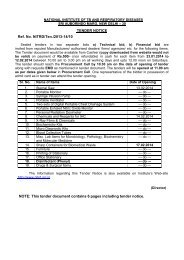October - LRS Institute of Tuberculosis & Respiratory Diseases
October - LRS Institute of Tuberculosis & Respiratory Diseases
October - LRS Institute of Tuberculosis & Respiratory Diseases
You also want an ePaper? Increase the reach of your titles
YUMPU automatically turns print PDFs into web optimized ePapers that Google loves.
172 K.V. THIRUVENGADAM ET AL<br />
<strong>of</strong> ‘the macrophage transiting through the interstitium to<br />
reach the terminal bronchiole.<br />
Immunoglobulins A (IgA) and E (IgE) are<br />
associated with secretions and it is not surprising that they<br />
play an important role in the defence <strong>of</strong> the respiratory<br />
tract. In fact, secretory IgA (a specialised form <strong>of</strong> IgA, with<br />
a secretory piece) and IgE are the antibodies involved in<br />
the primary defence <strong>of</strong> the lung and they are capable <strong>of</strong><br />
being synthesised locally by specialized B lymphocytes. On<br />
the other hand, T lymphocytes mediate delayed type<br />
hypersensitivity reactions which are characterised by<br />
granulomata. Such reactions are’ the hallmark <strong>of</strong> disorders<br />
like tuberculosis and sarcoidosis. Phagocytes and<br />
complement complete the rest <strong>of</strong> the components which<br />
make up the defense system <strong>of</strong> the lung.<br />
It is important to remember that while immune<br />
mechanisms play a crucial role in the pathogenesis <strong>of</strong><br />
occupational lung diseases due to dust, both inorganic and<br />
organic, nonimmunological pathways could also initiate<br />
occupational lung disease.<br />
Response <strong>of</strong> the lung to inorganic particles<br />
In the gas exchanging part <strong>of</strong> the lung, inorganic<br />
particles are ingested by alveolar macrophages. The<br />
response <strong>of</strong> the macrophage depends on the type <strong>of</strong><br />
particle ingested. For example, coal dust and haematite<br />
which are inert are sequestered within macrophages which<br />
transport them to other sites for expulsion. But a particle<br />
like silica causes macrophage dysfunction. Silica is readily<br />
ingested by the macrophage but is poorly handled<br />
thereafter. This leads to lysosomal injury either by bonding<br />
<strong>of</strong> silica to the membrane or by activation <strong>of</strong> membrane<br />
phosphalipases (de shazo RD 1’982). The end result is<br />
autolysis <strong>of</strong> the macrophage leaving the particle free to<br />
attack a fr esh macrophage. This impairment <strong>of</strong><br />
macrophage function renders the cell incapable <strong>of</strong> handling<br />
other agents such as mycobacteria.<br />
Asbestos has a different effect on the macrophage.<br />
Asbestos fibres cause the release <strong>of</strong> powerful enzymes<br />
within the macrophage and also stimulate arachidonic acid<br />
metabolism. In addition, they promote the release <strong>of</strong><br />
fibronectin (a substance which promotes fibrosis) and<br />
increase the number <strong>of</strong> surface receptors such as Fc (for<br />
immunoglobulins) and C a (for complement) suggesting an<br />
enhanced macrophage activity (Kagan E, 1981). A<br />
postulated defect <strong>of</strong> antigen presentation by macrophages<br />
in certain occupational lung diseases awaits confirmation.<br />
It has also been shown that the immunological<br />
background <strong>of</strong> the host also influences the handling<br />
mechanisms. For example, rheumatoid factor (RF) and<br />
antinuclear factor (ANF) have been found in individuals<br />
with occupational lung diseases more <strong>of</strong>ten than in<br />
normals (Turner Warnick, 1979). Rheumatoid factor is<br />
found frequently in silicosis, asbestosis and coal<br />
worker’s pneumononiosis. The relationships <strong>of</strong> these<br />
autoantibodies to occupational lung disease is not clearly<br />
defined. While it would appear, on one hand; that the<br />
increased incidence <strong>of</strong> RF is due to the adjuvant effect<br />
<strong>of</strong> silica (Pernis and Paronetoo, 1962) other evidence<br />
also shows that RF itself is an important factor in the<br />
production <strong>of</strong> silicosis (DeHoratius and Williams, 1972):<br />
Inaddition, depressed responses to Conconavalin A have<br />
been observed among silicotics suggesting loss <strong>of</strong><br />
suppressor T-cells. This might-explain the appaarance <strong>of</strong><br />
autoantibodies described in silicosis (Schulyer et al,<br />
1977). The occurrence <strong>of</strong> these autoantibodies and the<br />
immunoglobulin type vary with the type <strong>of</strong> dust<br />
ingested.<br />
Antinuclear factor is a good indicator or the<br />
prevalence and severity <strong>of</strong> disease in coal workers<br />
(CWP) and asbestosis. This is based on observations<br />
which suggest a high degree <strong>of</strong> correlation between AN$<br />
and the extent <strong>of</strong> radiological abnormalities and its more<br />
frequent occurrence in disease than RF (Lippman et al,<br />
1973).<br />
The pathological changes seen as consequence <strong>of</strong><br />
handling inorganic dust can be broadly grouped as<br />
under.<br />
(a) Interstitial fibrosis: This occurs When<br />
fibrosis <strong>of</strong> the alveoli is associated with thicken<br />
ing <strong>of</strong> the alveolar capillary membrane. This is<br />
commonly seen in exposure to dusts such as<br />
asbestos, beryllium and cobalt.<br />
(b) Nodular fibrosis: is commonly seen in<br />
silicosis. Silica is transported by macrophages<br />
to the interstitium and lymphnodes where<br />
autolysis leads to liberation <strong>of</strong> enzymes and<br />
development <strong>of</strong> fibrosis. This occurs away<br />
from the gas exchanging part <strong>of</strong> the lung near<br />
the respiratory bronchioles.<br />
(c) Interstitial and nodular fibrosis: A combi<br />
nation <strong>of</strong> the above two occurs in exposure<br />
to diatamaceous earth.<br />
(d) Macule formation and emphysema: When<br />
minimally fibrogenic materials such as coal<br />
are ingested by macrophages, effective clearance<br />
occurs as long as the macrophages are not<br />
overwhelmed by the number <strong>of</strong> particles. When<br />
the burden exceeds the capacity’ <strong>of</strong> the macrophages, dust<br />
particles are deposited around
















